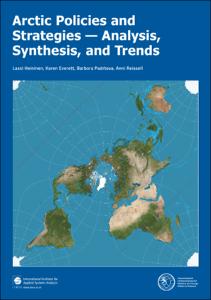| dc.contributor.author | Heininen, Lassi | |
| dc.contributor.author | Everett, Karen | |
| dc.contributor.author | Padrtova, Barbora | |
| dc.contributor.author | Reissell, Anni | |
| dc.coverage.spatial | Arctic Region | en_US |
| dc.date.accessioned | 2022-06-06T20:21:46Z | |
| dc.date.available | 2022-06-06T20:21:46Z | |
| dc.date.issued | 2020 | |
| dc.identifier.citation | Heininen, L., Everett, K., Padrtova, B. and Reissell, A. (2020) Arctic Policies and Strategies —
Analysis, Synthesis, and Trends. Laxenburg, Austria, International Institute for Applied Systems Analysis, 265pp. DOI: 10.22022/AFI/11-2019.16175 | en_US |
| dc.identifier.uri | https://repository.oceanbestpractices.org/handle/11329/1945 | |
| dc.description.abstract | The scientific report Arctic Policies and Strategies – Analysis, Synthesis and Trends delivers a holistic analysis of the policies, strategies,
and declarations of the relevant Arctic stakeholders. It also includes new and/or emerging trends of Arctic governance and
geopolitics in the early 21st century. The analysis, using quantitative and qualitative methods, is based on a coding of the text of
56 policy documents (in 1996-2019), namely: i) the strategies and policies of the Arctic States and the Arctic Council Observer
States; ii) the policies and declarations of the Arctic Indigenous peoples’ organizations (Permanent Participants); and iii) the main
Arctic Council chairmanship programs and ministerial declarations. It considers how different Arctic actors define and address
issues around the following: the human dimension, governance, international cooperation, environmental protection, pollution,
climate change, security, safety, economy, tourism, infrastructure, and science & education. Each document was read and analyzed
thoroughly; quotes were selected and coded and then used to compare and contrast (percentage-wise) how the different documents
address the above issues. For each category of stakeholder, the findings are compared within the category and then discussed with
each other category-wise. Our study shows that the most-coded quotes of the Arctic States’ policy documents relate to the Governance,
Economy, International Cooperation, and Human Dimension indicators, as well as to a new Environmental Protection
indicator (composed of Environmental Protection coupled with Pollution and Climate Change). The policy documents of the four
Indigenous peoples’ organizations explicitly address issues surrounding Indigenous rights, although in different contexts, and also
those related to the Governance indicator, both broadly and in detail. Unsurprisingly, all these documents emphasize the importance
of ‘Traditional knowledge.’ The most-quoted indicator in the Arctic policies/strategies of the nine Arctic Council Observer
states is the Science and Education indicator, followed by the International Cooperation and Economy indicators. The fourth
most-quoted is the new Environmental Protection indicator (composed of Environmental Protection coupled with Pollution and
Climate Change).
The analyses generated a separate list of new/emerging trends for each stakeholder, summarizing the current main themes and
concluding trends. Based on these, there here follows a short list of the overall new and/or emerging trends of the future of Arctic
governance and geopolitics: i) Ambivalence of Arctic development, including ‘political inability,’ whenever a balance is sought between environmental protection and economic activities; ii) The domination of States within the Arctic territory due to geopolitical
stability and sovereignty vis-à-vis internationalization/globalization, and due to international treaties and self-determination; iii)
Focus on science, with all Arctic stakeholders being dependent on scientific research and international cooperation in science for
problem-solving due to climate change; and iv) Close interrelationship between the Arctic and Space (e.g., digital security, satellites,
meteorology) due to globalization and rapidly advancing climate change in the Arctic. | en_US |
| dc.language.iso | en | en_US |
| dc.publisher | International Institute for Applied Systems Analysis | en_US |
| dc.rights | Attribution-NonCommercial 4.0 International | * |
| dc.rights.uri | http://creativecommons.org/licenses/by-nc/4.0/ | * |
| dc.subject.other | Arctic Council Observer States | en_US |
| dc.subject.other | Governance | en_US |
| dc.title | Arctic Policies and Strategies — Analysis, Synthesis, and Trends. | en_US |
| dc.type | Report | en_US |
| dc.description.status | Published | en_US |
| dc.format.pages | 265pp. | en_US |
| dc.description.refereed | Refereed | en_US |
| dc.publisher.place | Laxenburg, Austria | en_US |
| dc.identifier.doi | 10.22022/AFI/11-2019.16175 | |
| dc.subject.parameterDiscipline | Cross-discipline | en_US |
| dc.description.currentstatus | Current | en_US |
| dc.description.sdg | 14.a | en_US |
| dc.description.maturitylevel | Mature | en_US |
| dc.description.adoption | Multi-organisational | en_US |
| dc.description.adoption | International | en_US |
| dc.description.methodologyType | Reports with methodological relevance | en_US |
| obps.resourceurl.publisher | https://pure.iiasa.ac.at/id/eprint/16175/1/ArticReport_WEB_new.pdf | |
 Repository of community practices in Ocean Research, Applications and Data/Information Management
Repository of community practices in Ocean Research, Applications and Data/Information Management

